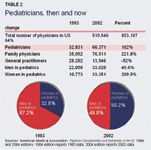"That was then, this is NOW! Contemplating 20 years of pediatrics"
In the years since Contemporary Pediatrics first hit physicians' desks, pediatric practice has undergone a phenomenal change. A longtime contributor and a former editor pause to consider just how far the specialty has come.
When Contemporary Pediatrics appeared, 20 years ago this month, it presented pediatricians with a new journal that provided up-to-date information in a comfortable, highly informative, and readable format. The Editor-in-Chief was Frank Oski, MD, chairman of pediatrics at SUNY Upstate Health Science Center in Syracuse; within a year he would move to Baltimore to take over the pediatric program at Johns Hopkins. Dr. Oski was well known as a wonderful educator and prolific author with a terrific sense of humor and an incredible ability to view pediatric medicine with just the right mix of seriousness and irreverence.
Jeff Forster was the first managing editor of Contemporary Pediatrics, and served as editor from 1985 to 1993. After his tenure at Contemporary Pediatrics, Jeff became editor of Patient Care, then Medical Economics, and then served as vice president, editorial and design, at Advanstar Medical Economics Healthcare Communications. Andrew Schuman, MD, a New Hampshire pediatrician, began contributing to Contemporary Pediatrics in 1988 with a brief article entitled "A quick and simple office newsletter." He's been contributing articles on office technologies and other topics ever since-more than 55 to date! Dr. Schuman has always written from the perspective of an office-based pediatrician practicing in the trenches of pediatric care. We've asked Jeff and Dr. Schuman to reminisce about the past two decades of pediatrics to celebrate and commemorate our anniversary. (For Dr. Schuman's personal reminiscences, see "1984: A pediatrician looks back."
In 1984, Ronald Reagan was re-elected President, defeating Walter Mondale. Michael Jackson's "Thriller" album-we had record albums back then-broke all industry records with sales topping 37 million copies. Sony introduced the first 3.5-inch computer disk. "The Cosby Show" and "Family Ties" were the most popular television programs. Unemployment was high, music CDs were gaining acceptance, and disco was a distant memory. The average cost of a new house was $97,600; a new car, $8,749. Gasoline was 97 cents a gallon; a first-class stamp, 20 cents; and tuition at Harvard topped out at $9,000 a year. We were still fighting the Cold War, and few could predict the eventual fall of communism.


Two decades of change Twenty years ago, medical care was certainly less complicated than it is today. Payment for office visits was usually fee-for-service, with the patient submitting bills to the insurance company for reimbursement. Managed care was yet to be, government regulation of medicine was minimal, and the pediatric immunization schedule was uncomplicated and straightforward. We had far fewer effective antibiotics, asthma medications, and antivirals. Many illnesses that threatened our patients then-such as epiglottitis and Reye's syndrome-are seen seldom if at all today. With each passing year pediatric medicine has improved, one baby step at a time. Over 20 years those small steps have accumulated, and the medicine we practice today is in many ways significantly better than that practiced in the 1980s.